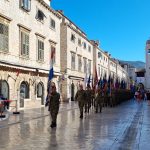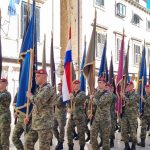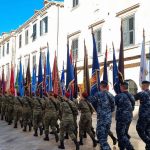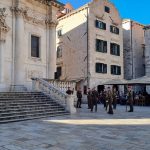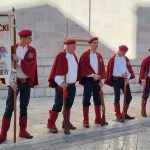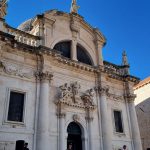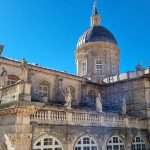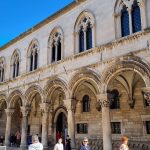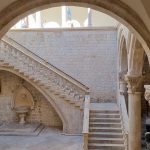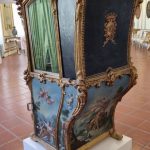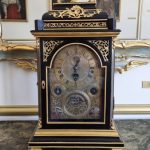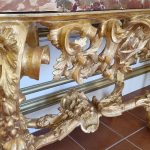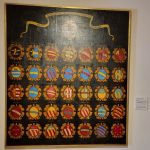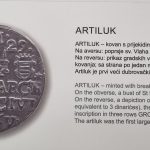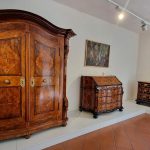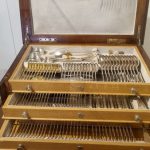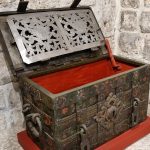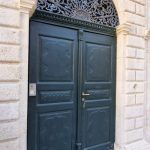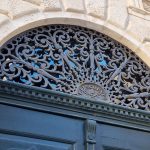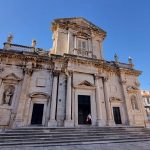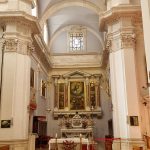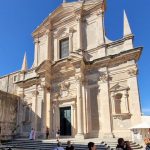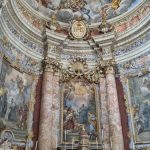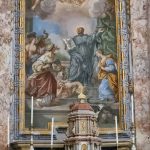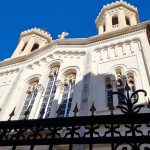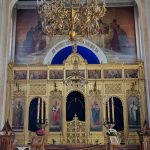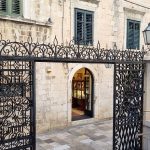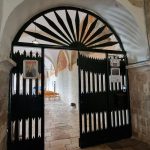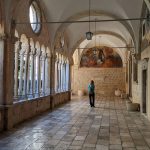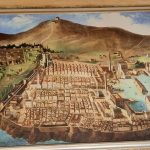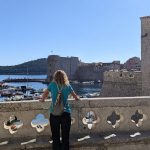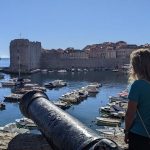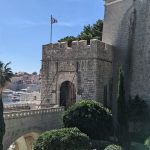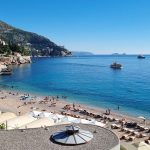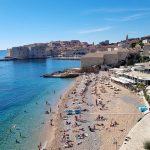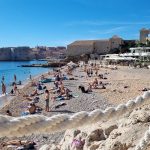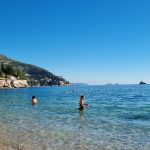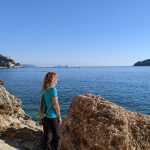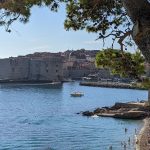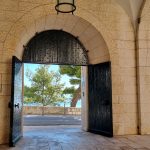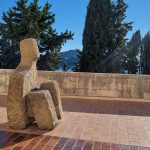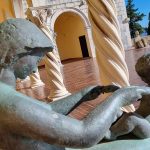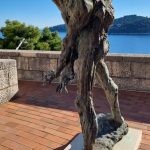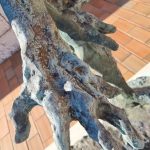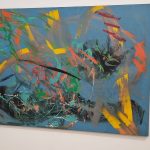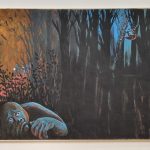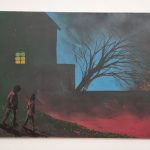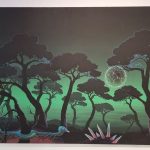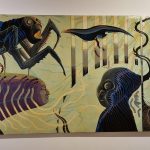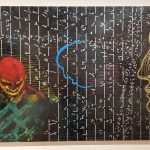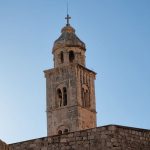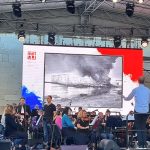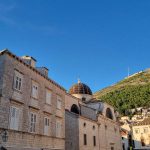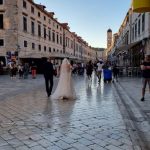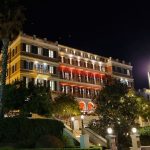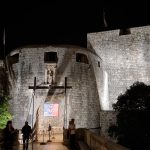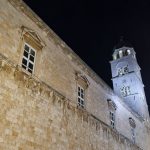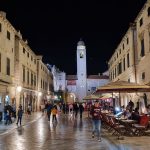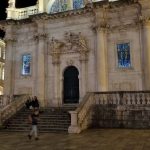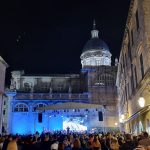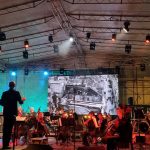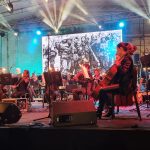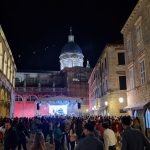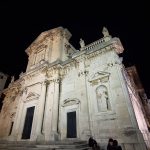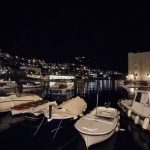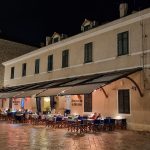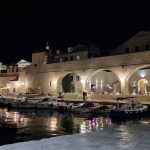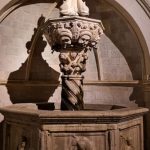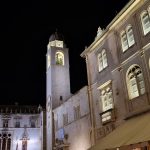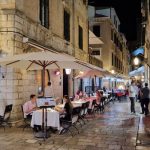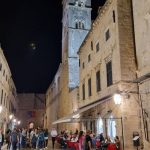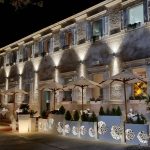Saturday 29th October 2022
Today we will spend the day in the Old Town of Dubrovnik. We have bought a 3 day pass to some of the sights of the Old Town, so we will visit some a Modern and Contemporay Art Museum, the Rector’s Palace and the Franciscan Monastery.
As we walked down the Main Street we chanced upon a procession of flag bearers in Army and Police uniform marching down the street, we are not sure why but we felt very lucky to see it.
Our First stop today is the Rector’s Palace – We enjoyed our time walking through the museum looking at all the old relics, paintings, furniture and other interesting objects, plus a display about the war in 1991. We also spoke with a girl who worked there and found out about the procession down the main street earlier this morning. Apparently October marks the anniversary of The Seige of Dubrovnik.
We then walked back to the Franciscan Monastery which was also very interesting. The monastery houses the inventory of the old Friars Minor Pharmacy from 1317, the well-preserved pharmacy furniture from the 16th century and the 15th and 16th century vases from Siena and Florence. Other exhibits include various presses, mortars, a 14th century still, manuscripts of recipes, precise scales, quarts, etc. In the Museum library there are valuable copies of manuscripts and chorales, as well as the valuable paintings by unknown masters, a 14th century head relic of St Ursula, and a collection of ex vuoto jewellery.
We then walked to the beautiful beach, enjoyed the sunshine, had a rest and a swim. The water was a little fresh but lovely all the same.
We then headed to the Museum of Contemporary and Modern Art which had some interesting sculptures, paintings and photography works. As always there was varied artworks which I always find interesting even though I don’t always understand them.
David headed home and as I walked back through town there was a performance by an orchestra with war pictures in the back ground. They were playing quite sombre and moving music. I watched this for a while and then headed back home for dinner.
I love being so close to the town as I was able to head back down there tonight to see the city under lights. David is still not well so he stayed home. The city was beautiful at night and the atmosphere was still celebratory. When I reached the stage in front of the Cathedral the performance was in full swing. There was a big crowd an dthe music was quite upbeat, with people in the crowds singing along. It had a really good vibe. I watched again for a while and then headed back home.
“The Rector’s Palace – One of the most significant monuments of profane architecture on the Croatian coast, the Rectors Palace, was the administrative centre of the Dubrovnik Republic. Its style is basically Gothic, with the Renaissance and Baroque reconstructions. Today the Rectors Palace houses the Cultural-historic Department of the Dubrovnik Museum with exhibition halls arranged to display the original setting with antique furniture and objects for daily use, as well as paintings by local and Italian masters. The Museum also guards a collection of old coins used in the Dubrovnik Republic, a collection of arms and utensils of Domus Christi Pharmacy from the 15th century. Apart from being exceptionally beautiful, the Rectors Palace Atrium has excellent acoustics, and is often used as a concert venue.”
“The Siege of Dubrovnik kicked off at around 6am on 1 October 1991 when the Yugo=slav Army (JNA) started their advance on the territory between the Pelješac and Prevlaka peninsulas on the coast of the Adriatic Sea. The JNA attacks and bombardment of Dubrovnik, including the Old Town – a UNESCO World Heritage Site – culminated on 6 December 1991 with 430 soldiers and 116 civilians killed. 2,127 homes were burnt in the Dubrovnik county, with 7,771 people left homeless. As many as 33,000 had to flee their homes during the siege and the JNA attacks. The bombardment provoked a strong international condemnation of the JNA and became a public relations disaster for Serbia and Montenegro, contributing to their diplomatic and economic isolation and international recognition of the independence of Croatia.”
- As we were walking down the street this procession headed towards us..
- ..it appears that they are carrying all sorts of different flags, maybe family crests, we are not sure..
- ..the leaders were from the army followed by the police, there was obviously something significant happening today..
- A display or gunmanship – they were very talented..
- ..further along there was what looked like a family crest.
- St Blaise’s Church..
- Assumption Cathedral..
- The Rector’s Palace..
- The stairway and foyer of the Rector’s Palace..
- Inside there were many carriages..
- ..some old clocks..
- ..lots of fancy side tables with ornate carvings..
- Armorial crests – I thought maybe these were the flags in the procession..
- ..some old coins – it was amazing craftsmanship for the age..
- ..some elaborate furniture..
- ..and silverware..
- ..and chests with elaborate locking mechanisms hidden under the decorative metal.
- ..an interesting door..
- ..with elaborate wrought iron decoration..
- The Cathedral of the Assumption of the Virgin Mary..
- ..the altar of the cathedral..
- Church of St Ignatius…
- ..is single nave, with side chapels and a semicircular divided apse..
- ..decorated by magnificent Baroque frescoes
- Church of the Holy Annunciation built in 1877..
- ..is a Serbian Orthodox church..
- ..outside the church..
- The Franciscan Monastery..
- ..was magnificent inside housing many religious relics – chalices, clothes, plus pharmacy relics..
- ..painting of the city with its surrounding city wall..
- ..looking out to the harbour outside the city walls.
- ..a cannon on the wall..
- ..the drawbridge at the exit of the Old Town..
- ..the beautiful waters of Banje Beach..
- ..it was picture postcard quality..
- ..as we head down to the beach..
- ..and go for a refreshing dip, then enjoy a little rest..
- ..as we head back up to explore some more..
- ..looking back towards the Old Town..
- Entrance to the Contemporary and Modern Art Museum..
- ..an interesting sculpture..
- ..a Mother and babe..
- I can’t remember what this sculpture was called..
- ..but I loved the gnarly hands..
- Remains of a Dream 1998
- Silent Observer 1995
- My Dream 2015
- Anxiety 1994
- Not sure of the name of this one..
- ..but I loved the detail (enlargement of left side)..
- Gregor and Full Moon 2014 – I loved the detail in this one too..
- Binary Code is not the Only Code 2009
- The Cathedral dome..
- ..the live orchestra performance was quite sombre this afternoon..
- ..as we head out of the Old Town this afternoon..
- ..there was a wedding couple having some photos taken in the Main Street..
- As I head back down this evening – the fancy hotel was all lit up..
- ..as was the entry to the Old Town, as I approach the draw bridge..
- ..the buildings always look lovely illuminated..
- ..as does the street with its polished marble paths..
- St Blaise’s Church..
- The crowds in front of the Cathedral enjoying the performance..
- ..it was very moving..
- ..the music was quite uplifting this evening..
- ..it was even celebratory, the people were singing and clapping along.
- Dubrovnik Cathedral..
- ..the harbour..
- ..a harbourside restaurant with a pleasant singer..
- ..the harbour again..
- ..a fountain..
- ..the Rector’s Palace..
- ..another sidewalk restaurant in the Main Street..
- ..as I head out of town..
- ..I enjoy another gelato – this one a Queen Anny – vanilla with boysenberry. Yummy.
- .. A lovely looking restaurant as I head home.
